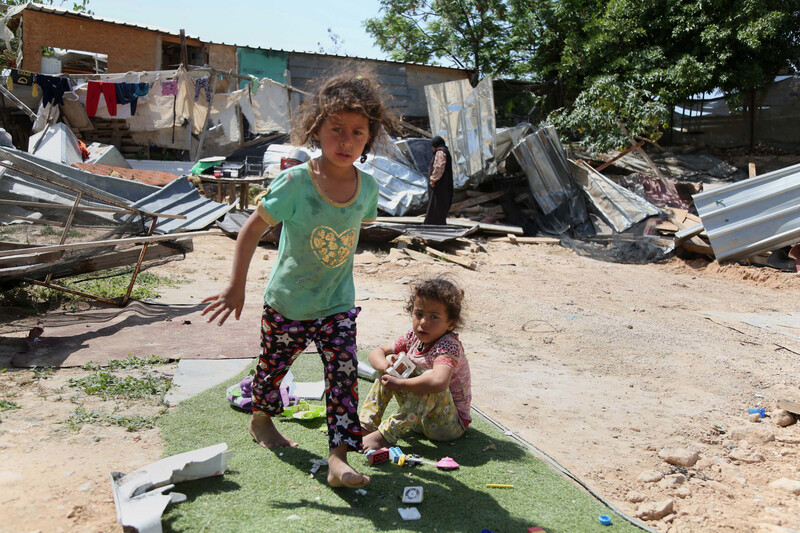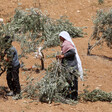Rights and Accountability 9 January 2018

Children playing in rubble after Israeli forces demolished four homes in Khan al-Ahmar, April 2016.
APA imagesIsrael forcibly displaced more than 650 Palestinians in the occupied West Bank in 2017 by demolishing their homes.
In total, occupation forces destroyed 400 structures in the West Bank, according to UN figures.
More than 100 of the demolished structures had been funded by international donors. Another 12,500 are under threat from pending Israeli demolitions orders.
Israel systematically denies Palestinians under military occupation in the West Bank, including East Jerusalem, permission to build on their own land.
Much of its destruction has targeted communities in Area C, the roughly 60 percent of the West Bank that remains under full Israeli military control under the terms of the Oslo accords signed between Israel and the Palestine Liberation Organization in the early 1990s.
Israel drops legal pretense
Palestinians are forced to build without permits and live in constant fear that their homes will be demolished. Israeli politicians are increasingly calling for the permanent annexation of Area C, which would leave the majority of Palestinians in the West Bank corralled into tiny islands of territory.
Although 2016 marked a record year for Israel’s demolitions, – almost 1,100 structures were destroyed displacing 1,600 Palestinians – Israel began in 2017 bypassing legal formalities in order to expedite the expulsion of Palestinians.
“It seems that Israel is so confident in its ability to expel entire villages without incurring judicial or international criticism that it is no longer bothering to create even the illusion of legal proceedings,” according to Israeli human rights group B’Tselem.
Fast-track expulsion
Previously Israel would issue military orders requiring specific building plans and had protracted procedures including “precise mapping of the land and buildings, as well as the issuing of separate demolition orders for each building,” B’Tselem states.
But in the last year, Israel began relying on a military order concerning “unauthorized buildings” to carry out quick expulsions of Palestinians. That order had originally been intended for the eviction of settlers from settlement outposts established without Israeli permission, although it was rarely ever used for that purpose, according to B’Tselem.
While Israel distinguishes between “unauthorized” and “authorized” settlements – and often retroactively converts the former into the latter – all of its settlements are illegal under international law.
By using this order, Israel targets entire communities for forced removal without bothering to issue specific demolition orders for each building.
This order was never previously used on Palestinians.
Now, communities threatened with expulsion by Israel view this as a continuation of the Nakba – the ethnic cleansing of more than 750,000 Palestinians by Zionist militias in 1948.
B’Tselem says that it is “virtually unprecedented since 1967” – the year Israel occupied the West Bank – for entire communities to be demolished.
In September, the human rights group warned that Israeli leaders including Prime Minister Benjamin Netanyahu could be personally liable for war crimes if they proceed with the planned demolitions of two such communities, Khan al-Ahmar and Susiya, to make way for Israeli settlements.
According to the UN, the number of demolitions and seizures of Palestinian structures in 2017 in Area C was 265 to the end of November, compared with almost 900 for all of 2016.
“However, obtaining construction permits remains nearly impossible as a result of a restrictive and discriminatory planning regime,” according to UN humanitarian coordination agency OCHA.
Susiya’s 340 residents have been living under constant threats of expulsion for years, fighting many legal battles with Israel to remain on the land they’ve been on since the 1800s.
Rare intervention
In November, Israel renewed its demolition order against the Area C village, announcing that it could destroy about a fifth of Susiya’s structures within weeks.
That prompted a rare intervention from 10 US senators who wrote to Netanyahu urging him “not to demolish the Palestinian village of Susiya and the Bedouin community of Khan al-Ahmar.”
Khan al-Ahmar, also in Area C, lies between the Israeli settlements of Maaleh Adumim and Kfar Adumim in the so-called E1 area of the West Bank.
The E1 area is targeted by Israel for expansion of its mega-settlement of Maaleh Adumim, which would complete the encirclement of Jerusalem and isolate the northern and southern parts of the West Bank from each other.
Israel issued evacuation orders to Khan al-Ahmar multiple times in the past year, prompting strong condemnation from human rights groups.
Khan al-Ahmar is home to approximately 175 members of the Jahalin tribe. Israel is threatening to destroy its only school.
In addition, Israeli forces harass residents by confiscating building materials.
In November, Israel also ordered all 300 residents of the Jabal al-Baba community, also in E1, out of their homes within eight days.
Villagers are refusing to comply and have held protests against their expulsion.
The Jabal al-Baba community was originally in the southern Naqab (Negev) region, before its members were forcibly displaced to their present location near Jerusalem.
Khan al-Ahmar and Jabal al-Baba are two of 12 Palestinian communities, with a total of about 1,400 residents in the area east of Jerusalem which face Israeli expulsion.
Israeli forces also issued expulsion orders to the communities of Ein al-Hilweh and Umm Jamal in the northern Jordan Valley on 9 November, giving residents eight days to evacuate.
There are over 20 families in the northern Jordan Valley area who face expulsion.
One reason Israel gets away with these expulsions is that the international donors that fund the schools and other facilities Israel is destroying have done nothing to hold it accountable.
Tags
- OCHA
- B'Tselem
- settlement outposts
- Nakba
- Susiya
- Area C
- Oslo accords
- Palestine Liberation Organization
- Khan al-Ahmar
- Maaleh Adumim
- Kfar Adumim
- E1
- Benjamin Netanyahu
- Jahalin Bedouin
- Impunity
- Jabal al-Baba
- Negev (Naqab)
- Ein al-Hilweh
- Ein al-Hilwe
- Umm Jamal
- jordan valley
- demolitions
- home demolitions
- house demoltions




